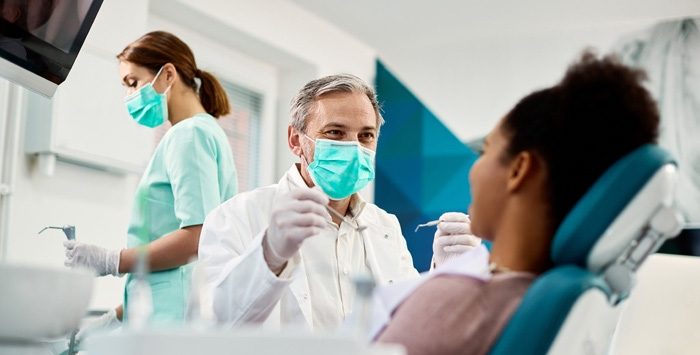Medicare and dental coverage: Key takeaways
For half a century, Medicare has provided comprehensive health insurance coverage to America’s seniors. But dental coverage isn’t included in Original Medicare or Medigap plans.
So even with a very solid health plan via Original Medicare + Medigap + Part D prescription drug coverage, dental care is an out-of-pocket expense. And that’s becoming an increasing challenge as the cost of dental care rises: From 1990 to 2016, average per-capita spending on dental care increased by 81% (after adjusting to keep all of the amounts in 2016 dollars).
Dental crisis in United States
Nearly half of Medicare beneficiaries have no dental insurance at all, and nearly half of all Medicare beneficiaries have not seen a dentist in the last year. That’s worrisome not just for oral health, but also for overall health. There’s a significant link between untreated dental disease and various other systemic ailments, including heart disease and diabetes.
Oral cancer is seven times more likely to be diagnosed in people over age 65, and routine dental check-ups are an excellent means of detecting oral cancer.
About one out of six Americans age 65 or older indicated that they hadn’t seen a dentist in the past year due to cost barriers. And more than one in five Medicare beneficiaries have not seen a dentist in the last five years.
About 20% of Americans age 65+ have untreated dental cavities. And about 20% of Americans age 65 and older are missing all of their natural teeth, although there is significant variation in tooth retention based on geographic area, income, and education level; seniors in rural areas are especially hard hit by a lack of access to oral health care.
There is no doubt that we have a dental crisis in the U.S. And although the ACA deemed dental coverage for children to be an essential health benefit, there’s no requirement that adults have dental coverage, or that insurance carriers provide it (it’s worth noting that this is also the case in several other developed countries that do provide universal medical coverage for their residents; dental care is less likely to be covered under those programs).
Coverage of routine dental care wasn’t built into Medicare
Medicare was never designed to include routine dental care; Medicare’s coverage of dental expenses is limited to situations where the dental treatment is integral to other medical treatment (for example, an extraction prior to radiation treatment for oral cancer, or jaw reconstruction following an accident). Although, as noted in this brief from the Center for Medicare Advocacy, CMS has some flexibility when it comes to how the rules are interpreted.
While health insurance plans generally pick up the tab for large medical bills, it’s rare to find dental coverage that doesn’t leave enrollees on the hook for significant bills if they need extensive dental work. This is generally true across a wide range of plan types, including Medicare Advantage dental coverage, stand-alone dental plans, and group dental plans for employees and retirees. Dental plans commonly have benefit maximums of $1,000 or $2,000 per year, and a single root canal can cost well over $1,000, while an implant can be as much as $7,500 per tooth.
But some coverage is better than nothing. Even with low benefit maximums, people who have dental insurance are more likely to receive routine preventive dental care, and are less likely to have untreated dental problems that get worse over time.
Sources of dental coverage
Roughly 10% of retirees retain dental coverage from their former employer or a spouse’s employer. But there are other options available for seniors who don’t have access to employer-sponsored dental coverage.
Medicare Advantage is an alternative to Original Medicare for enrollees who want dental coverage. In 2022, 94% of Medicare Advantage plans provide at least some dental coverage. If you’re considering Medicare Advantage instead of Original Medicare + Medigap + Medicare Part D, be sure to familiarize yourself with the pros and cons of both options. And be aware that the average benefit cap for dental care under Medicare Advantage plans is about $1,300, and more than half of enrollees are in plans that cap dental benefits at under $1,000 per year.
Stand-alone dental plans are available for purchase, and some carriers offer dental plans that are specifically designed for seniors. But again, it’s typical for them to have relatively low annual benefit maximums. For example, AARP partners with Delta Dental to offer a plan for AARP members and the available PPO options have annual benefit caps of $1,000 or $1,500 (they also have an HMO option that doesn’t have an annual benefit cap, although it’s not available in all areas, and requires members to get their care from in-network dentists, with care coordinated by a primary care dentist). This guide is a helpful resource for understanding how individual dental plans work.
For low-income seniors who are dual-eligible for Medicare and Medicaid, limited dental benefits (including dentures) can be provided by Medicaid, but coverage varies considerably from state to state.
Efforts to add dental care to Medicare have been unsuccessful, due in part to the ADA’s lobbying influence
High-quality dental insurance for adults — particularly those enrolled in Medicare — remains elusive. Bills are routinely introduced in Congress to add dental care to Medicare’s list of covered services, but have thus far not been successful.
It’s noteworthy that the American Dental Association opposes the addition of dental benefits to Medicare, due to concerns that Medicare would not pay dentists as much as they want to be paid for their services.
In 2021, Senator Ben Cardin (D, Maryland) introduced the Medicare Dental Benefit Act of 2021 (S.97). The legislation, which Cardin has introduced several years in a row, calls for Medicare Part B to cover services “that are necessary to prevent disease and promote oral health, restore oral structures to health and function, and treat emergency conditions.” These would include things like cleanings, exams, x-rays, fillings, extractions, root canals, crowns, dentures, emergency dental care, and “other necessary services related to dental and oral health.”
S.97 did not advance in the 2021 session. And the Build Back Better Act, which passed in the House in late 2021 but then stalled in the Senate, initially called for dental benefits to be added to Medicare but that provision was removed before the House passed the bill. That happened due to lobbying from the ADA, and it happened despite the fact that the American public indicated that their number one priority for the legislation was the addition of dental and vision coverage to Medicare.
If this is important to you, you can contact your elected representatives to urge them to work towards adding dental benefits to Medicare.
The bipartisan Action for Dental Health Act of 2018 has been applauded by consumer advocates and the dental industry as a step towards improving Americans’ oral health via a grant-based program, but it’s also controversial in that much of its focus is on improving education and awareness surrounding oral health, as opposed to actually increasing access to care (the legislation does include some measures that help to expand access to care, particularly for vulnerable populations).
Programs that help
For seniors who have no dental coverage, a variety of programs can help them obtain dental care:
- Dental schools will often provide treatment at a reduced price. (Here’s a list of accredited dental schools in the United States.)
- For low-income seniors, dental care is available on a sliding fee scale at community health centers. You can use this tool to find a community health center near you.
- The Dental Lifeline Network coordinates dental care nationwide for elderly, disabled, and medically fragile populations. More than 15,000 dentists donate their time to provide dental care for patients who would not otherwise be able to afford treatment.
- Many dentists offer payment plans, or will refer patients to a credit source, often with low initial interest rates. Read the fine print though, because interest rates can reach credit card levels after the introductory period is over.
- Dental savings plans are readily available, without waiting periods or restrictions on their use. But they are not considered insurance, and they don’t pay anything on your behalf when you receive treatment. Instead, dental discount plans simply utilize a network of dentists who agree to charge a reduced rate for plan members. And although some discount plans offer significantly reduced rates for routine care like x-rays and exams, they typically provide only very small rate reductions for more extensive dental work.
- Brighter is an online tool that self-pay dental patients can use to compare local dental prices and gain access to pre-negotiated rates.
- And of course, some patients simply opt to receive dental care in a foreign country, finding it less expensive – even after accounting for travel costs – than obtaining dental care here in the US.
So while there are programs available to help seniors obtain affordable dental care, in many cases, Medicare beneficiaries must pay out-of-pocket for their dental care, and many simply forgo dental treatments altogether.
The Affordable Care Act has substantially reformed our healthcare system, but dental coverage remains out of reach for many American adults. That’s especially true for retirees who no longer have access to employer-sponsored insurance.
Louise Norris is an individual health insurance broker who has been writing about health insurance and health reform since 2006. She has written dozens of opinions and educational pieces about the Affordable Care Act for healthinsurance.org. Her state health exchange updates and open enrollment guide are regularly cited by media who cover health reform and by other health insurance experts.



